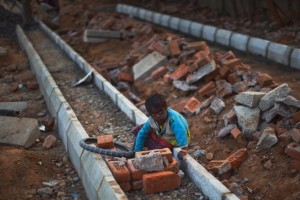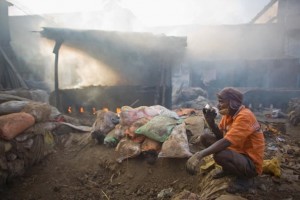

Follow us on:  
|

Considerable global attention is being received by the countries of the BRICS, amongst others, who are seen as ’emerging countries’. The expansion of the G-7 to the G-20 has come about more due to such recognition that these emerging economies would constitute the axis for the global economy, currently being threatened by a double-dip recession, to relaunch itself into a high growth trajectory.
The lynchpin for such a strategy would of course be the efforts to prise open these economies and markets further for international finance capital to maximise profits in a global situation where hitherto familiar terrains have virtually dried up.
India and China receive considerably greater attention as economies that have shown positive growth rates in the global atmosphere of decline or stagnation. The stories of both India and China however, are dramatically different.
China has concentrated on strengthening its domestic demand in the background of global economic slowdown thus shifting its strategy from an export oriented growth towards domestic demand driven growth. This to a large extent explains its dramatic turnover of its manufacturing sector in recent months.
India however, is focussing on attracting greater inflow of international capital with the hope that this will make available larger investments which in turn would lead to higher growth levels. This can happen only on the condition that what is produced by this incremental investment can be sold to generate both profits and growth.

A small child plays on a construction site in New Delhi. [Getty Images]
India is currently going through one of the worst years of economic growth. The GDP growth rate for this fiscal year ending will be announced soon and by no estimation will not cross 6 per cent compared to an initially hoped 8-9 per cent.
This slowing down of the economy is accompanied by the natural consequences of greater unemployment and lower levels of incomes. On top of this, the real earnings of the people continue to be significantly devalued because of the relentless rise in the prices of all commodities particularly food items. This has dramatically widened the hiatus between the two India’s – shining for the rich and suffering for the poor.
By now there is a fair amount of consensus that GDP growth rates alone cannot capture the overall quality of life of the people. Various human development indices are being used by various countries and the United Nations. In 2009, the then French president Sarkozy appointed a committee that included two Nobel laureates in Economics, Joseph Stiglitz and Amartya Sen, whose report on ‘The measurement of economic performance and social progress’ similarly called for a more comprehensive set of indicators to capture the actual quality of life of the people.
In fact growing economic inequalities have been a singular feature for the last two decades of globalisation and its neo-liberal economic reforms. The Economist carried a special report recently stating: “More than two-thirds of the world’s people live in countries where economic inequalities have risen since 1980, often to a startling degree”. It concludes saying, “Inequality has reached such a stage where it can be inefficient and bad for growth”.
Nobel laureate Joseph E Stiglitz has written a new book, The Price of Inequality. He argues markets have an inexorable tendency for greater accumulation of capital thus dividing society into what he calls the top 1 per cent vs the other 99 per cent. Incidentally, Karl Marx had presciently analysed this tendency of centralisation and concentration of capital more than 150 years ago. In his conclusion, Stiglitz says, “Our economic growth, especially if properly measured, will be much higher than what we can achieve if our society remains deeply divided.”
The Time magazine recently carried a special cover report on “Reinventing India”. At one place, this report says, “For over two decades, since the economic liberalisation of the early nineties India has indulged in the gratifications and titillations of a market economy”. Among many of its positive results, the report says that, “But it (reform) has also led to unprecedented levels of corruption and environmental degradation, and created new forms of deprivation and dispossession among those left behind by the economic reforms”.
The World Bank Report on Global Hunger 2012 ranks India at number 65 out of 79 countries. Worse, it observes, “According to latest data on child undernutrition, from 2005-10, India ranked second to last on child underweight out of 129 countries. Only Timor-Leste (try to locate this country on the map) had a higher rate of underweight children.” A “national shame”, as our Prime Minister says.

The Dharavi slum in Mumbai, India. [Getty Images]
When John Maynard Keynes called for State intervention to revive the global economy after the great depression of the 1930s, market fundamentalists opposed this by arguing that the markets will bring about a balance in the long run. Keynes famously remarked that in the long run, all of us will be dead!
With State intervention, it is perfectly possible for us in India to tackle our growing economic inequalities and achieve a sustainable inclusive growth pattern. Where will resources for such State intervention come from? Last year’s Union budget tells us that tax concessions to the rich and the corporates were Rs. 5280 billion, while the current high fiscal deficit is Rs 5220 billion. While subsidies for the poor are being drastically cut, such huge subsidies for the rich, we are told, are ‘incentives’ for growth. Yet, growth in the manufacturing sector declined from 3.6 per cent in July 2011 to 0.1 per cent in July 2012.
If these legitimate taxes were collected and used for public investments to build India’s much needed infrastructure, it would have generated significant additional employment. The consequent improvement in people’s livelihood will enlarge domestic demand leading to a sustainable growth trajectory. This, of course, requires a qualitative shift from the present trajectory of economic reforms.